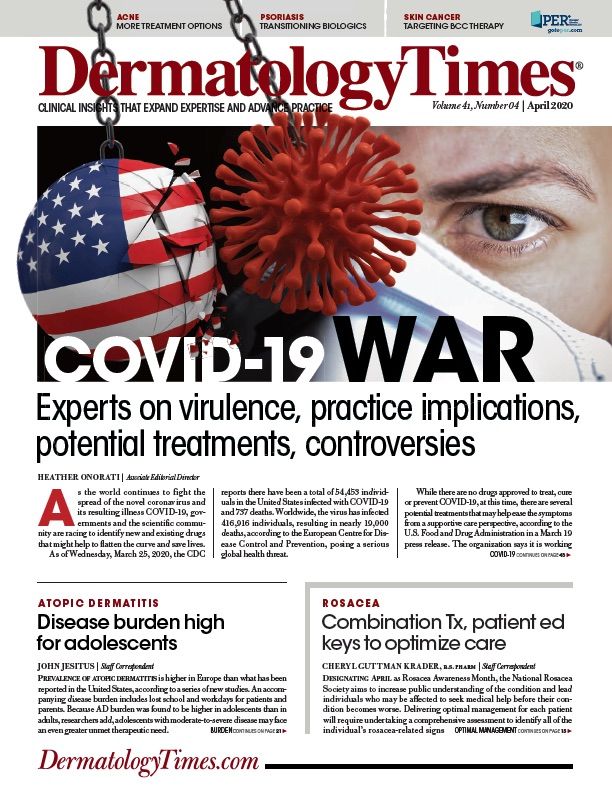- Case-Based Roundtable
- General Dermatology
- Eczema
- Chronic Hand Eczema
- Alopecia
- Aesthetics
- Vitiligo
- COVID-19
- Actinic Keratosis
- Precision Medicine and Biologics
- Rare Disease
- Wound Care
- Rosacea
- Psoriasis
- Psoriatic Arthritis
- Atopic Dermatitis
- Melasma
- NP and PA
- Skin Cancer
- Hidradenitis Suppurativa
- Drug Watch
- Pigmentary Disorders
- Acne
- Pediatric Dermatology
- Practice Management
- Prurigo Nodularis
- Buy-and-Bill
Publication
Article
Dermatology Times
Microneedling plus radiofrequency effective
Author(s):
Glynis R. Ablon, M.D., spoke at the 18th annual South Beach Symposium in Miami about why microneedling with radiofrequency is an effective way to combat signs of aging skin. According to Dr. Ablon, benefits include minimal downtime and risk versus other options.
Dr. Glynis Ablon

Microneedling with radiofrequency can be a valuable addition to a dermatologic practice because it effectively treats a variety of skin aging signs and other defects both on and off the face with minimal risk and downtime compared with alternative options, according to Glynis R. Ablon, M.D., who spoke at the 18th annual South Beach Symposium, Miami. Dr. Ablon says microneedling with radiofrequency is a great option for skin tightening and resurfacing to treat wrinkles, lip lines, acne scars, other depressed scars, and stretch marks, and it can be used regardless of skin phototype.
“One of the great things about microneedling with radiofrequency is that it is color blind. Unlike with lasers, microneedling with radiofrequency delivers energy in a way that is not chromophore dependent. Therefore, it is safe to use in patients with darker skin types,” says Dr. Ablon, associate clinical professor of dermatology, David Geffen School of Medicine at UCLA, Los Angeles, Calif., and founder and director, Ablon Skin Institute & Research Center, Manhattan Beach, Calif.
MORE: DAXI appears, safe, effective
“In addition, because microneedling with radiofrequency has good depth control and delivers energy directly into the target area without loss of energy it can be used with greater safety to treat certain problems that would otherwise require an aggressive laser or peel resurfacing procedure,” she says.
She adds, however, that achieving optimal outcomes can require multiple sessions.
“I tell patients they typically will need three or four treatments to achieve the best results. One of the biggest mistakes that clinicians make when using this technology is that they tell patients they will only need one session,” Dr. Ablon says.
Depending on the patient’s presentation, a combination approach incorporating other treatment modalities may also be preferred. Microneedling with radiofrequency can be combined with a variety of other treatments, including platelet-rich plasma injections, resurfacing lasers, chemical peels, and subcision.
Providing an example, Dr. Ablon says that when treating a patient for acne scars, she will use a 100% trichloroacetic acid peel to address deep icepick scars and then use microneedling with radiofrequency on surrounding skin and scars.
MINIMAL MORBIDITY
Setting appropriate expectations for post-treatment sequelae is important for achieving patient satisfaction. The type and severity of postprocedural reactions and the duration of downtime depend on the nature of the treatment, Dr. Ablon says.
With mild treatments, patients generally experience no postoperative pain and little to no social downtime. Treatments performed with more aggressive parameters are associated with more sequelae, but generally patients only experience mild to moderate postoperative pain and minimal downtime.
“Most patients can return to work in a few days but they need to expect prepared to have visible prick marks on the skin that can persist for three to five days,” Dr. Ablon says.
A topical anesthetic is used to improve patient comfort during the procedure, although a nerve block may be used when treating around the mouth. To minimize complications, patients should be advised to avoid using any anti-inflammatory treatments for 2 weeks prior to the procedure and retinoids for three days.
To prevent herpes reactivation, patients who are being treated around the mouth are started on valacyclovir with dose adjustment as necessary for renal impairment. Due to the risk of folliculitis, valacyclovir along with an oral antibiotic are prescribed for all patients who are having a more aggressive treatment or who have a history of fol- liculitis with a previous treatment.
“To avoid complications, always maintain sterility throughout the procedure,” Dr. Ablon adds.
PURCHASING DECISIONS
With a number of devices on the market that differ in a variety of features, clinicians may wonder which system to choose. The first issue to consider, however, is whether microneedling with radiofrequency is a good fit for their practice, Dr. Ablon says.
“Think about the types of patients that you see. If your aesthetic focus is on hair removal, then a microneedling-radiofrequency system is not for you,” she says. “If you are looking to add services for acne scars, traumatic scars, wrinkles and/or laxity, then a microneedling device with radiofrequency is a great addition.”
The available systems vary in the type of needles they use, including whether the needles are insulated or not and whether they are variable or fixed lengths. Insulated needles are designed to protect the epidermis. They emit radiofrequency energy only at the tip and cause low volume heating.
“With insulated needles, multiple passes (penetrations) are needed, and the associated trauma results in bleeding and subsequently more downtime for patients,” Dr. Ablon says.
Non-insulated microneedles are active along the entire length and cause high volumetric heating. “Because only a single pass is needed when using a system with non-insulated needles, treatments with non-insulated needles carry advantages for shorter procedure time, less trauma, and less downtime. However, I still typically proceed with three passes to achieve more dramatic results on the majority of my patients.”
RELATED: Not all toxin types, concentrations provide the same results
Needle depth is an important consideration because penetration into the dermis is necessary to stimulate collagen production and tissue tightening, Dr. Ablon says.
She notes that her preference is for needles that can penetrate between 0.5 and 5.0 mm. She also likes needles that are gold-plated and tapered, which allows for smooth penetration through the epidermis and dermal-epidermal junction, thereby avoiding unnecessary trauma to the skin and minimizing the risk of pigmentary changes with non-insulated needles
TREATMENT PARAMETERS
Skin thickness is a consideration for choosing appropriate settings. Dr. Ablon says that she uses a shorter pulse width and needle penetration depth when treating skin on the hands, the neck, or periorbital areas than for procedures on the cheeks or upper lip.
“For enhanced clinical effect it is possible to cover the area with additional passes of pulses, but do not stack pulses because stacking can lead to excess heating of tissue that could cause damage or burn,” she says.
“In addition, I may do two passes with radiofrequency and a third superficial pass with microneedling alone, setting the radiofrequency power to 0. This third pass without radiofrequency is working more superficially and so I do not need the heat as much as I want the collagen induction that can be gotten from the needling alone as well as the zones of trauma in the epidermis for more contraction.”
Disclosures:
Dr. Ablon is a speaker for Endymed and MTDerm and receives research grants from MTDerm.






